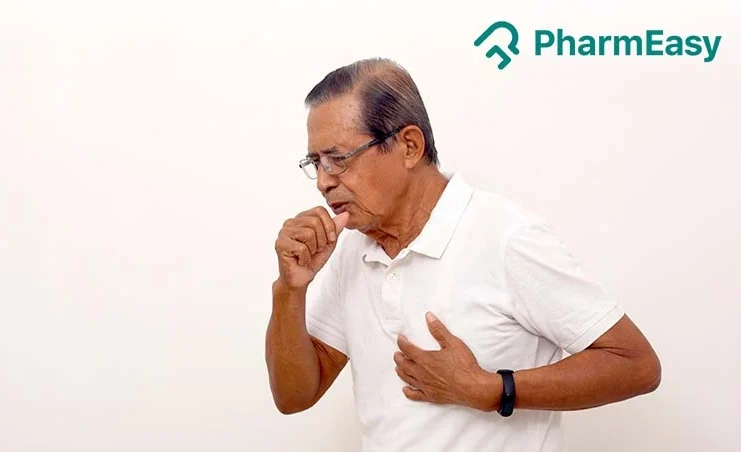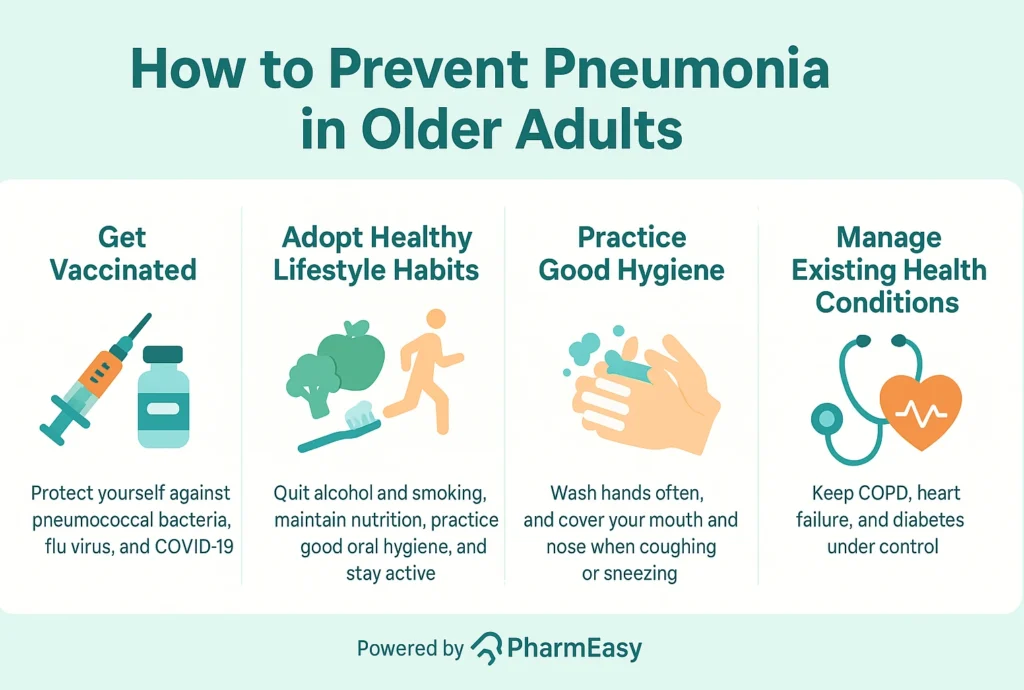Pneumonia in the Elderly: Causes, Symptoms, Treatment, and Prevention
By Dr. Vishesh Bharucha +2 more

Get,

to manage your symptom
Get your,


4 Cr+ families
benefitted

OTP sent to 9988776655



You’ve successfully subscribed to receive
doctor-approved tips on
Whatsapp

Get ready to feel your best.

Hi There,
Download the PharmEasy App now!!


Register to Avail the Offer
Send OTPBy continuing, you agree with our Privacy Policy and Terms and Conditions

Hi There,
Sign up on PharmEasy now!!
Trusted by 4 crore+ families

OTP sent to 9988776655



You have unlocked 25% off on medicines




Code: NU25
By Dr. Vishesh Bharucha +2 more
Table of Contents
As people get older, they become more susceptible to infections, and a common one is the lung infection called pneumonia. It happens when bacteria, viruses, fungi or other uncommon germs enter the lungs. In the elderly, the body’s defence system becomes weak, so germs can easily enter the airways1,2. This leads to infection in the lungs where a thick fluid called inflammatory exudate, made up of immune cells, proteins and germs build up in the air spaces, causing trouble in breathing and symptoms like cough and chest pain2,3.
It is a serious concern in older people because the illness can get worse quickly, and recovery becomes more difficult. They are more likely to get a severe form of pneumonia and need hospital admission4. There are chances of death also, seen in about 5 to 15% of people admitted to the hospital, and it can rise to 30 to 50% in those who are seriously ill and need intensive care1.

But it can be managed better if we know about symptoms of pneumonia in elderly, how it is treated, and how it can be prevented, which we will discuss further in this blog5.
Pneumonia in elderly is grouped based on where and how they catch the infection. The common types are:
All these types of pneumonia in elderly may be caused by either a bacterium, a virus, a fungus, or a parasite that has infected the lungs2,6. Let us see what causes these types of pneumonia in the next section.
Bacteria are the most common cause of pneumonia in elderly population. It can happen mainly in two ways:
• By accidentally breathing in food or stomach contents (aspiration pneumonia)
• By catching the infection from air or people around (airborne pneumonia)
Here is a table that shows what causes pneumonia in elderly and how they spread6,7:
| Type | From Swallowed Material | From Air or People |
| Community-Acquired | Staphylococcus, Klebsiella, E. coli | Streptococcus, Haemophilus, Mycoplasma, flu, COVID, fungi |
| Hospital-Acquired | Pseudomonas, Acinetobacter, MRSA, Klebsiella | Legionella, Aspergillus, Candida, CMV |
| Ventilator-Associated | Same as hospital-acquired | Germs from machines: Legionella, fungi, viruses |
Among these, Streptococcus pneumoniae is the most common bacteria seen in elderly patients.
Some elderly people may get infected with strong germs that do not respond to certain antibiotics. These are hard to treat and are often seen in those who had pneumonia earlier, are admitted to the hospital often, or received injectable antibiotics in the last 90 days6.
There are other risk factors that make elderly people more likely to get pneumonia, which will be discussed in detail in the next section.
As the body ages, the immune system becomes slower, and other health issues and some medicines can increase the risk of pneumonia, as given below:
Elderly people who lie flat for long periods, have trouble swallowing, use feeding tubes, are very drowsy, or have poor mouth hygiene are at risk of getting aspiration pneumonia. Tumours in the mouth or airways can also raise the risk5.
Symptoms of pneumonia in elderly individuals may not always be typical, and only some may have common signs like:
Others may just show vague symptoms. These include:
Sometimes, other signs like sudden falls may be seen. These are not direct symptoms of pneumonia, but when the infection spreads in the body, it can cause weakness, dizziness, or low blood pressure, leading to falls.
In people with existing heart or lung conditions, pneumonia can make those illnesses worse, even if they are not symptoms of pneumonia itself5,15.
If such symptoms appear, doctors may suspect pneumonia. A fast breathing rate (over 25 per minute) or low oxygen (below 90%) may suggest infection. However, low oxygen is not specific to pneumonia, it shows that the lungs are not working properly, and the illness may be severe. To confirm, imaging tests like X-ray or CT scan and blood tests may be done. Treatment will be started early5,13.
Treatment for pneumonia in older people is planned based on how severe the condition is and where the person is being treated, either at home or in the hospital. The table below shows common treatments depending on the patient’s condition5,13.
| Patient Condition | Medicines Commonly Given |
| Treated at home with no other health problems | Antibiotics like amoxicillin are commonly used, especially if Streptococcus pneumoniae is expected. Azithromycin or doxycycline may also be used, but azithromycin alone is not preferred in areas where resistance is high. |
| Treated at home but has other health issues | Combination of two antibiotics like amoxicillin with azithromycin can be given. Or a single broad antibiotic like levofloxacin may also be given. |
| Admitted to hospital but not in ICU | Same as above but given through a vein (IV) and under close watch. Usually a beta-lactam antibiotic like ceftriaxone with azithromycin, or just a strong one like levofloxacin. |
| Admitted to ICU but no risk of severe infections | Strong antibiotics like ceftriaxone or cefepime, with azithromycin or levofloxacin. Doctors also check if any resistant organisms like MRSA or Pseudomonas are possible. |
| Lungs have pus or fluid buildup like abscess or empyema | Strong antibiotics or special ones like clindamycin may be added, especially if food or fluid accidentally entered the lungs. |
Along with antibiotics, in severe cases, steroids are given to calm the immune system. Oxygen and IV fluids help with breathing and hydration. Patient is watched closely to see if they get better or have any issues. Recovery depends on how well they respond to the treatment5,13.
Recovery from pneumonia in older people is often slower compared to younger people. If the treatment for pneumonia in elderly is in the hospital, it may take up to 8 weeks or longer to fully recover, while people treated at home may feel better sooner. Even after the person feels better, the chest X-ray may still show signs of infection. This is common in older people and does not always mean the pneumonia is still active13.
While recovering:
Recovery also depends on the person’s ability to do daily activities. Those who are weak or have other health issues may take longer to recover and may face complications1,13.
In people who are very old and frail and have other diseases like heart or kidney problems, pneumonia recovery can be hard, and complications may occur.
These problems are common in elderly pneumonia when not treated early. Symptoms like confusion or delirium may lead to poor outcomes2,6.

Pneumonia in elderly individuals can be dangerous with complications, but by preventing it, you can make sure you’re ageing healthily and maintain your quality of life. Here are some ways how to prevent pneumonia in elderly:
So, by getting vaccines, following infection control, and managing chronic illnesses, you can reduce the risk of pneumonia.
The following symptoms of pneumonia in elderly people require medical attention:
Signs like trouble breathing, bluish lips, or low blood pressure need urgent care.
Especially those who have heart disease, diabetes, or kidney problems should not wait but see the doctor early so they can avoid complications and recover faster3,16.
Also Read: UTI in the Elderly: Symptoms, Causes, Treatment, and Prevention
Pneumonia in older people can be serious and even life-threatening if not treated early. However, with the right medicines, along with good nutrition, proper care for existing health problems, and support for any complications, pneumonia in elderly can show good recovery. Closely watch for symptoms like cough, fever, breathing trouble, or confusion. So, knowing the signs and risks helps you visit the doctor in time and start appropriate treatment to avoid any complications of pneumonia from occurring.
Also Read: Adult Diaper Rash: Causes, Symptoms, Treatment & Home Remedies
If you are older and have poor dental hygiene, you may be at risk of getting pneumonia. When you do not brush properly, bacteria can build up in the mouth. These bacteria can accidentally enter the lungs and cause pneumonia6.
Yes, pneumonia can affect your nutrition. The illness causes your body to use up nutrients faster, and many people eat less when they are sick. This can lead to poor nutrition, which may slow recovery and lead to worse outcomes6.
People who have trouble swallowing, lie down for long hours, use feeding tubes or oxygen, take painkillers, or have poor mouth hygiene are more likely to get aspiration pneumonia5.
Yes, a geriatrician checks for problems that can make pneumonia worse, like poor nutrition, weakness, memory loss, or confusion. They address these issues early, give the right support and medical care, and help reduce the risk of getting pneumonia6.
Disclaimer: The information provided here is for educational/awareness purposes only and is not intended to be a substitute for medical treatment by a healthcare professional and should not be relied upon to diagnose or treat any medical condition. The reader should consult a registered medical practitioner to determine the appropriateness of the information and before consuming any medication. PharmEasy does not provide any guarantee or warranty (express or implied) regarding the accuracy, adequacy, completeness, legality, reliability or usefulness of the information; and disclaims any liability arising thereof.
Comments

Leave your comment...
You may also like
Comments